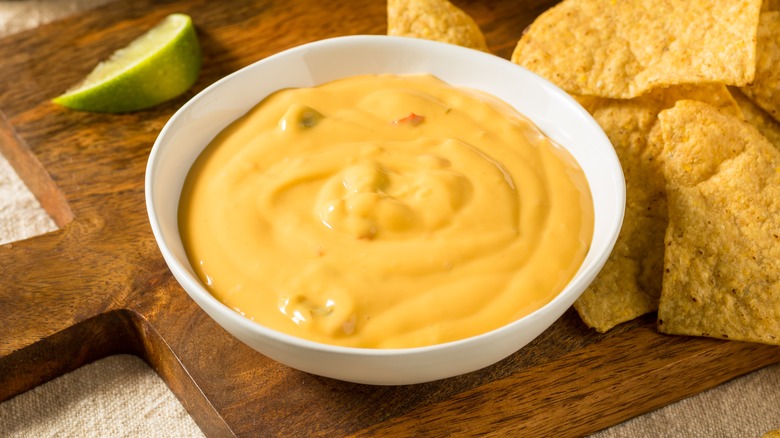The Major Nacho Cheese Sauce Mistakes To Avoid, According To An Expert
We may receive a commission on purchases made from links.
Nachos are an interesting appetizer in that there are two distinct styles. The original kind — said to have been invented by accident — consists of cheese baked on top of chips. Nacho recipes these days may also include all manner of over-the-top ingredients such as corned beef, peanut butter, or apples. However, another type of nachos became a staple at ballparks and movie concession stands due to its simplicity; it consists of nothing more than tortilla chips drizzled or dunked in nacho cheese sauce with maybe a side of pickled jalapeños.
While ballpark nachos may owe their popularity to the fact that they're easily prepared onsite, they're also something you may want to make at home. In that case, you'll need to be careful with the nacho cheese sauce, assuming you want to start from scratch. Sure, you could just warm up a jar of the stuff, but for the dedicated DIYer, Mashed has obtained sauce-making advice from Keyshawn Hudson, author of "Food Family Repeat: Recipes for Making Every Day a Celebration."
As Hudson explains, to ensure a smooth sauce, you'll need to keep an eye on the heat. If the sauce gets too hot, he says that this "can cause the cheese to become stringy or grainy." He also notes that most nacho cheese sauce recipes (like ours) call for a thickener such as flour in addition to melted cheese and milk. If you omit the thickener, he says that this may "lead ... to a runny consistency."
The kind of cheese counts, too
Okay, we know you're probably sick to death of all those tirades against pre-shredded cheese. To listen to some food writers rant, you'd think the stuff kicked their kitten. We'll admit it has its time and place in the kitchen, namely any time when you don't want to run the risk of shredding your knuckles on a box grater or go through the bother of hauling out your food processor. Still, if you do want a super-smooth nacho cheese sauce, then pre-shredded cheese won't be your best bet. As Keyshawn Hudson points out, it has added ingredients (specifically, anti-clumping agents like potato starch) that may hinder its ability to melt.
If you have a large bag of shredded cheese you need to use up, though, or you really don't want to make yourself grate again, you can try other ideas. For example, an immersion blender can help smooth out any clumps that result from making cheese sauce with the pre-shredded stuff. You could also try adding a pinch of sodium citrate, as this may help a cheese sauce to emulsify. Additionally, you might want to consider adding some sliced American cheese to the mix, since it seems that more pasteurized, processed types of cheese (or cheese foods) also make for smoother sauces.

